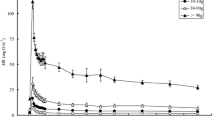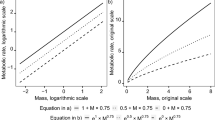Abstract
Metabolic scaling is hypothesized to be affected by ontogenetic changes in the body chemical composition because several body components do not consume significant amounts of oxygen but contribute more to body mass (M) as a fish grows. We tested this hypothesis by assessing the mass scaling of the resting metabolic rate (RMR) and body compositions of lipid, protein, ash, and water in four species of cyprinids, Hypophthalmichthys molitrix (M range 9.5–218.3 g), Cyprinus carpio (M range 14.6–226.9 g), Carassius auratus (M range 4.5–323.2 g), and Ctenopharyngodon idellus (M range 5.8–274.2 g). The oxygen consumption of fasting fish was determined using a continuous flow respirometer at 25 °C and was used to assess the RMR. Then, the fish bodies were dried to a constant weight and used to determine the proximate compositions. No significant correlations were detected between the RMR and the masses of water, lipid, or ash after controlling for the wet mass in any species. The scaling exponents for the masses of lipid and/or ash were significantly >1; however, lipid and ash represented only a small proportion of the body mass of all four fish species. These results suggest that the increasing proportion of lipid and ash only explains a limited part of the metabolic scaling, and factors other than inert components may have a greater contribution. There was no significant difference between the metabolic scaling exponent for the wet mass and dry mass in all four species, suggesting that using either the wet or dry body mass has only a limited effect on the metabolic scaling exponent.



Similar content being viewed by others
References
Bokma F (2004) Evidence against universal metabolic allometry. Funct Ecol 18:184–187
Brown JH, Gillooly JF, Allen AP, Savage VM, West GB (2004) Toward a metabolic theory of ecology. Ecology 85:1771–1789
Clarke A, Johnston NM (1999) Scaling of metabolic rate with body mass and temperature in teleost fish. J Anim Ecol 68:893–905
Dillon ME, Frazier MR (2013) Thermodynamics constrains allometric scaling of optimal development time in insects. PLoS ONE 8:e84308
Finn RN, Rønnestad I, van der Meeren T, Fyhn HJ (2002) Fuel and metabolic scaling during the early life stages of Atlantic cod Gadus morhua. Mar Ecol Prog Ser 243:217–234
Fu SJ, Zeng LQ, Li XM, Pang X, Cao ZD, Peng JL, Wang YX (2009) The behavioural, digestive and metabolic characteristics of fishes with different foraging strategies. J Exp Biol 212:2296–2302
Gifford ME, Clay TA, Peterman WE (2013) The effects of temperature and activity on intraspecific scaling of metabolic rates in a lungless Salamander. J Exp Zool A 319:230–236
Glazier DS (1991) Separating the respiration rates of embryos and brooding females of Daphnia magna: implications for the cost of brooding and the allometry of metabolic rate. Limnol Oceanogr 36:354–362
Glazier DS (2005) Beyond the ‘3/4-power law’: variation in the intra- and interspecific scaling of metabolic rate in animals. Biol Rev 80:611–662
Glazier DS, Butler EM, Lombardi SA, Deptola TJ, Reese AJ, Satterthwaite EV (2011) Ecological effects on metabolic scaling: amphipod responses to fish predators in freshwater springs. Ecol Monogr 81:599–618
Hartman KJ, Margraf FJ (2008) Common relationships among proximate composition components in fishes. J Fish Biol 73:2352–2360
Huang QD, Zhang YR, Liu ST, Wang W, Luo YP (2013) Intraspecific scaling of the resting and maximum metabolic rates of the crucian carp (Carassius auratus). PLoS ONE 8:e82837
Jobling M (1994) Fish bioenergetics. Chapman and Hall, London
Jonsson N, Jonsson B (1998) Body composition and energy allocation in lifehistory stages of brown trout. J Fish Biol 53:1306–1316
Jonsson N, Jonsson B (2003) Energy allocation among developmental stages, age groups, and types of Atlantic salmon (Salmo salar) spawners. Can J Fish Aquat Sci 60:506–516
Killen SS, Costa I, Brown JA, Gamperl AK (2007) Little left in the tank: metabolic scaling in marine teleosts and its implications for aerobic scope. Proc R Soc B 274:431–438
Killen SS, Atkinson D, Glazier DS (2010) The intraspecific scaling of metabolic rate with body mass in fishes depends on lifestyle and temperature. Ecol Lett 13:184–193
Kozłowski J, Konarzewski M, Gawelczyk AT (2003) Cell size as a link between noncoding DNA and metabolic rate scaling. Proc Natl Acad Sci USA 100:14080–14085
Luo YP, Huang QD, Zhang YR, Liu SR, Wang W (2013) Comparison of the body proximate compositions of juvenile bronze gudgeon (Coreius heterodon) and largemouth bronze gudgeon (C. guichenoti) in the upstream region of the Yangtze River. Springerplus 2:75
Luo YP, He DC, Li G, Xie H, Zhang YR, Huang QD (2015) Intraspecific metabolic scaling exponent depends on red blood cell size in fishes. J Exp Biol 218:1496–1503
Marsden ID, Shumway SE, Padilla DK (2012) Does size matter? The effects of body size and declining oxygen tension on oxygen uptake in gastropods. J Mar Biol Assoc UK 92:1603–1617
Oikawa S, Itazawa Y (1993) Tissue respiration and relative growth of parts of body of a marine teleost, porgy Pagrus major, during early life stages with special reference to the metabolism–size relationship. Comp Biochem Physiol A 105:741–744
Pangle KL, Sutton TM (2005) Temporal changes in the relationship between condition indices and proximate composition of juvenile Coregonus artedi. J Fish Biol 66:1060–1072
Peck MA, Buckley LJ, Bengtson DA (2004) Effects of temperature, body size and feeding on rates of metabolism in young-of-the-year haddock. J Fish Biol 66:911–923
Sears KE, Kerkhoff AJ, Messerman A, Itagaki H (2012) Ontogenetic scaling of metabolism, growth, and assimilation: testing metabolic scaling theory with Manduca sexta larvae. Physiol Biochem Zool 85:159–173
Simčič T, Brancelj A (2003) Estimation of the proportion of metabolically active mass in the amphipod Gammarus fossarum. Freshw Biol 48:1093–1099
Wang QQ, Wang W, Huang QD, Zhang YR, Luo YP (2012) Effect of meal size on the specific dynamic action of the juvenile snakehead (Channa argus). Comp Biochem Physiol A 161:401–405
Weathers WW, Siegel RB (1995) Body size establishes the scaling of avian postnatal metabolic rate: an interspecific analysis using phylogenetically independent contrasts. Ibis 137:532–542
West GB, Brown JH, Enquist BJ (1997) A general model for the origin of allometric scaling laws in biology. Science 276:122–126
Yan GJ, He XK, Cao ZD, Fu SJ (2013) An interspecific comparison between morphology and swimming performance in cyprinids. J Evol Biol 26:1802–1815
Zhang YR, Huang QD, Liu ST, He DC, Wei G, Luo YP (2014) Intraspecific mass scaling of metabolic rates in grass carp (Ctenopharyngodon idellus). J Comp Physiol B 184:347–354
Acknowledgments
This study was supported by the National Natural Science Foundation of China (31000958), the Natural Science Foundation Project of CQ (CSTC2013jcyjA80023), and the Fundamental Research Funds for the Central Universities (XDJK2014C157).
Author information
Authors and Affiliations
Corresponding author
Additional information
An erratum to this article can be found at http://dx.doi.org/10.1007/s10695-016-0278-3.
Rights and permissions
About this article
Cite this article
Li, G., Xie, H., He, D. et al. Effects of body chemical components on the allometric scaling of the resting metabolic rate in four species of cyprinids. Fish Physiol Biochem 42, 295–301 (2016). https://doi.org/10.1007/s10695-015-0137-7
Received:
Accepted:
Published:
Issue Date:
DOI: https://doi.org/10.1007/s10695-015-0137-7




